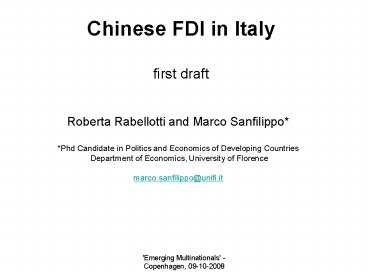Chinese FDI in Italy first draft - PowerPoint PPT Presentation
1 / 17
Title:
Chinese FDI in Italy first draft
Description:
Chinese FDI in Italy ... (194), followed by finance and banking (24), wholesale and retail services and transports (Figure 3). In the manufacturing industry, ... – PowerPoint PPT presentation
Number of Views:22
Avg rating:3.0/5.0
Title: Chinese FDI in Italy first draft
1
Chinese FDI in Italyfirst draft
- Roberta Rabellotti and Marco Sanfilippo
- Phd Candidate in Politics and Economics of
Developing Countries - Department of Economics, University of Florence
- marco.sanfilippo_at_unifi.it
2
Research Outline
- Review of the theoretical literature on emerging
multinationals - Analysis of Chinese MNEs competitive advantages
and motivations of Chinese FDI - Evidence from European countries setting Italy
in the European perspective - Mapping Chinese FDI in Italy
- Preliminary considerations based on secondary
evidence - Research on the field (to be done)
3
Chinese FDI in Europe- country level evidence
4
Chinese FDI in Europe- Firm level evidence
(greenfield)
5
UK, Germany France
- UK
- Finance and manufacturing (electronics, textiles,
automotive) - Sales Mkt and Headquarters (telecomm.)
- MA Automotive (Rover) Chemicals Renewable
energy - Germany
- Manufacturing and trade companies
- Sales marketing
- MA TCL-Schneider electronics, recent interests
in automotive and machineries (Invest in Germany) - France
- Chinese FDI as rising source of employment (IFA,
2007) - Electronics (Hisense), chemicals, finance (Exim
Bank) - MAs TCL- Thomson TCL- Alcatel
BlueStar-Rhodia/Adisseo
6
Chinese FDI in Italy (AT Kerney, 2008)
- A first phase, starting from the 1960s of
flagship investments such as the establishment
of the commercial office of Air China in Rome in
1986 - A second phase, from the mid 1980s to the 1990s,
characterized by episodic investments, among
which in 1986 the Chinese Nanjing Automotive
Corporation opening a representative office in
Turin and in 1988 the Cemate Group which opened a
commercial office to start selling Chinese
machineries in Italy - A third phase, which started at the end of the
1990s and it is characterized by the entry in
Italy of Chinese global players (such as Haier,
COSCO, Baosteel) as well as by an increasing
number of acquisition operations.
7
Mapping Chinese FDI in Italy- the dataset
- 56 Chinese FDI in Italy (incl. 3 ceased)
- ICE-Reprint database
- Previous studies AT Kerney, 2008 Bellabona and
Spigarelli, 2007 Spigarelli, 2008 - MOFCOM Italy
- Specialized press.
8
Evolution in the quality of Chinese FDI in
Italy
9
..as well as in the modalities of entry
10
Sectoral and geographical distribution
11
The logistic sector from defensive to offensive
market-seeking investments
- COSCO and China Ocean Shipping Company (HQ) in
Naples and Genoa - Initially, joint-ventures and strategic alliances
with local enterprises and setting up of
commercial offices (defensive investments) - Recently, acquisition of European companies and
investment in new infrastructural projects
(offensive investments) aimed at the
acquisition of market shares and more valuable
positions in global logistic chain
12
The home appliances sector market and
asset-seeking investments
- The home appliances sector is a mature industry,
characterized by a producer-driven global value
chain - Chinese firms have built their production
capabilities working initially as subcontractors
for developed country MNEs - Then, they have been able to develop their own
products and brands, initially sold in the
domestic market - This has allowed to the domestic firms to acquire
some competitive advantages on the basis of whose
they have begun their internationalization
strategies.
13
Haiers European HQ in Varese
- Acquisition of strategic assets at the level of
the firm technology, human capital, distribution
networks - Agglomeration advantages
- Specialized labor market
- Specialized suppliers of components and parts
- Specialised knowledge on markets and technologies.
14
The pure strategic asset-seeking investments
- Automotive companies in Turin (Anhui and
Changan) RD and design centers - Acquisition of technology and brand
Quianjiang-Benelli (motorcycle producer) - Brands Hembly-Sergio Tacchini (sportswear),
Xinyu Hengdel Group-Omas (luxory goods).
15
Preliminary considerations
- Evidence is still scarce, only few key operations
- Pattern of entry in Italy similar to other main
European countries - However, Italy holds some distinctive comparative
advantages e.g. economies of agglomeration in
traditional sectors.. - ..but also some distinctive disadvantages in
attracting FDI high bureaucracy and restrictive
policy on visa concession
16
Preliminary considerations
- Italys manufacturing model built largely on
SMEs has proven vulnerable to Chinese
competition - Chinese FDI, in perspective, may provide some
benefits to domestic economic system - Focus on strategic competitive advantages
- Fresh capital
- Sale networks
- Access to rapidly increasing global Asian market.
17
Research on the field
- Nonetheless, more first-hand information is
needed to answer basic questions as - At the country level Does the pattern of Chinese
investment in Italy differ from other European
destinations, if so why? Does the pattern of
Chinese investment differ from other investors to
Italy, if so why? - At the local level How do Chinese investors
enter into local linkages? What is the impact
(threat or opportunity) of the Chinese presence
on the local cluster? - At the firm level Are Chinese subsidiaries in
Italy building up competences? How dothey
transfer within the company these competences
acquired locally?































